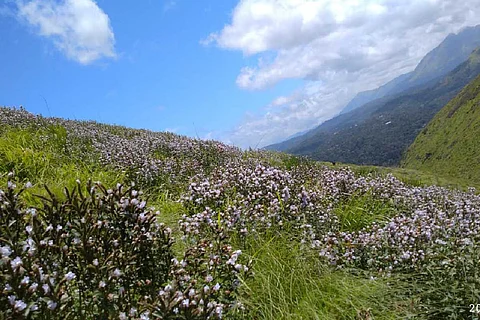

Neelakurinji or Strobilanthes kunthiana, the famous plant whose purplish flowers blossom once in 12 years in Kerala’s Western Ghats, has blossomed in the hills of Idukki’s Santhanpara panchayat. The neelakurinji has bloomed in over 10 hectares of the Shalom Hills or Kizhakkathi Mala, close to the Shola National Park in the district.
The rare Neelakurinji flowers, that grow upto 30 to 60 centimetres high, bloom only once in the plant’s lifetime. The phenomenon occurs once in 12 years, following which the plant perishes. Of the 450 species of the Strobilanthes genus, 146 species are found in India and 43 are found in Kerala - one of which is Neelakurinji (Strobilanthes kunthiana). The plant gets its local name ‘neelakurinji’ from the unique light purple hue of its flower. Idukki’s Munnar is known for the wondrous spectacle of this rare plant’s mass blossoming, as it is home to the largest concentration of neelakurinji plants in India.
The last time Munnar witnessed the mass blooming of the neelakurinji in the Anamalai Hills of the Eravikulam National Park was in 2018. The flowers carpeted thousands of hectares along the hills, and attracted several thousands of visitors to view the spectacle. The present neelakurinji bloom, however, is about 50 km south-west of Munnar, in Santhanpara panchayat near the Pampadum Shola National Park. According to Forest Department officials, the bloom is seen outside the park limits.
“What is usually considered as a marvel by everyone is the mass blooming of neelakurinji which takes place in the Eravikulam National Park. This is known as gregarious flowering, where plants of the same gene pool in a landscape flower as a mass. Whereas in sporadic flowering, it will be a small area where flowering occurs. In both cases, the plant perishes, leaving behind its seeds. The next generation of plants continue from this,” says Job J Nerimparambil, Assistant Wildlife Warden of Eravikulam National Park.
Different populations of neelakurinji are observed in the Western Ghats hills in Idukki district, of which the most famous is in the Anamalai Hills. According to officials, similar small-scale flowering of the neelakurinji was observed in parts of the Shola forests last year as well.